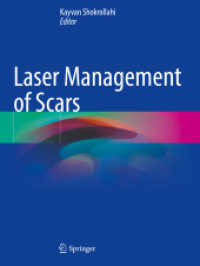- ホーム
- > 洋書
- > 英文書
- > Science / Mathematics
Full Description
Principles of Virology, the leading virology textbook in use, is an extremely valuable and highly informative presentation of virology at the interface of modern cell biology and immunology. This text utilizes a uniquely rational approach by highlighting common principles and processes across all viruses. Using a set of representative viruses to illustrate the breadth of viral complexity, students are able to under-stand viral reproduction and pathogenesis and are equipped with the necessary tools for future encounters with new or understudied viruses.This fifth edition was updated to keep pace with the ever-changing field of virology. In addition to the beloved full-color illustrations, video interviews with leading scientists, movies, and links to exciting blogposts on relevant topics, this edition includes study questions and active learning puzzles in each chapter, as well as short descriptions regarding the key messages of references of special interest. Volume I: Molecular Biology focuses on the molecular processes of viral reproduction, from entry through release. Volume II: Pathogenesis and Control addresses the interplay between viruses and their host organisms, on both the micro- and macroscale, including chapters on public health, the immune response, vaccines and other antiviral strategies, viral evolution, and a brand new chapter on the therapeutic uses of viruses. These two volumes can be used for separate courses or together in a single course. Each includes a unique appendix, glossary, and links to internet resources.Principles of Virology, Fifth Edition, is ideal for teaching the strategies by which all viruses reproduce, spread within a host, and are maintained within populations. This edition carefully reflects the results of extensive vetting and feedback received from course instructors and students, making this renowned textbook even more appropriate for undergraduate and graduate courses in virology, microbiology, and infectious diseases.
Contents
Preface xviiAcknowledgments xxiAbout the Authors xxiiiKey of Repetitive Elements xxvPart I The Science of Virology 11 Foundations 2Luria's Credo 3Viruses Defined 3Why We Study Viruses 3Viruses Are Everywhere 3Viruses Infect All Living Things 4Viruses Can Cause Human Disease 5Viruses Can Be Beneficial 5Viruses "R" Us 6Viruses Can Cross Species Boundaries 6Viruses Are Unique Tools To Study Biology 6Virus Prehistory 7Viral Infections in Antiquity 7The First Vaccines 8Microorganisms as Pathogenic Agents 9Discovery of Viruses 11The Defining Properties of Viruses 13The Structural Simplicity of Virus Particles 13The Intracellular Parasitism of Viruses 13Cataloging Animal Viruses 18The Classical System 18Classification by Genome Type: the Baltimore System 19A Common Strategy for Viral Propagation 21Perspectives 21References 24Study Questions 242 The Infectious Cycle 26Introduction 27The Infectious Cycle 27The Cell 27Entering Cells 28Viral RNA Synthesis 29Viral Protein Synthesis 29Viral Genome Replication 29Assembly of Progeny Virus Particles 29Viral Pathogenesis 29Overcoming Host Defenses 30Cultivation of Viruses 30Cell Culture 30Embryonated Eggs 35Laboratory Animals 35Assay of Viruses 35Measurement of Infectious Units 35Efficiency of Plating 38Measurement of Virus Particles 40Viral Reproduction: The Burst Concept 49The One-Step Growth Cycle 49One-Step Growth Analysis: a Valuable Tool for Studying Animal Viruses 52Global Analysis 53DNA Microarrays 54Mass Spectrometry 56Protein-Protein Interactions 56Single-CellVirology 56Perspectives 58References 59Study Questions 60Part II Molecular Biology 613 Genomes and Genetics 62Introduction 63Genome Principles and the Baltimore System 63Structure and Complexity of Viral Genomes 63DNA Genomes 64RNA Genomes 65What Do Viral Genomes Look Like? 68Coding Strategies 69What Can Viral Sequences Tell Us? 69The "Big and Small" of Viral Genomes: Does Size Matter? 71The Origin of Viral Genomes 73Genetic Analysis of Viruses 74Classical Genetic Methods 75Engineering Mutations into Viral Genomes 77Engineering Viral Genomes: Viral Vectors 83Perspectives 87References 87Study Questions 884 Structure 90Introduction 91Functions of the Virion 91Nomenclature 92Methods for Studying Virus Structure 92Building a Protective Coat 95Helical Structures 96Capsids with Icosahedral Symmetry 99Other Capsid Architectures 111Packaging the Nucleic Acid Genome 112Direct Contact of the Genome with a Protein Shell 112Packaging by Specialized Viral Proteins 113Packaging by Cellular Proteins 113Viruses with Envelopes 115Viral Envelope Components 115Simple Enveloped Viruses: Direct Contact of External Proteins with the Capsid or Nucleocapsid 117Enveloped Viruses with an Additional Protein Layer 118Large Viruses with Multiple Structure Elements 119Particles with Helical or Icosahedral Parts 120Alternative Architectures 123Other Components of Virions 125Enzymes 125Other Viral Proteins 125Cellular Macromolecules 126Mechanical Properties of Virus Particles 126Investigation of Mechanical Properties of Virus Particles 126Stabilization and Destabilization of Virus Particles 128Perspectives 128References 129Study Questions 1305 Attachment and Entry 132Introduction 133Attachment of Virus Particles to Cells 133General Principles 133Identification of Receptors for Virus Particles 135Virus-Receptor Interactions 137Entry into Cells 142Virus-induced Signaling via Cell Receptors 142Routes of Entry 143Membrane Fusion 145Intracellular Trafficking and Uncoating 154Movement of Viral and Subviral Particles within Cells 154Uncoating of Enveloped Virus Particles 155Uncoating of Nonenveloped Viruses 155Import of Viral Genomes into the Nucleus 159The Nuclear Pore Complex 159Nuclear Localization Signals 159Nuclear Import of RNA Genomes 161Nuclear Import of DNA Genomes 162Import of Retroviral Genomes 162Perspectives 164References 165Study Questions 1666 Synthesis of RNA from RNA Templates 168Introduction 169The Nature of the RNA Template 169Secondary Structures in Viral RNA 169Naked or Nucleocapsid RNA 170The RNA Synthesis Machinery 171Identification of RNA-Dependent RNA Polymerases 171Three-Dimensional Structures of RNA-Dependent RNA Polymerases 173Mechanisms of RNA Synthesis 176Initiation 176Capping 179Elongation 179Functions of Additional Polymerase Domains 181RNA Polymerase Oligomerization 181Template Specificity 182Unwinding the RNA Template 182Role of Cellular Proteins 183Paradigms for Viral RNA Synthesis 183(+) Strand RNA 184Synthesis of Nested Subgenomic mRNAs 184( ) Strand RNA 185Ambisense RNA 189Double-Stranded RNA 189Unique Mechanisms of mRNA and Genome Synthesis of Hepatitis Delta Virus 190Do Ribosomes and RNA Polymerases Collide? 192Origins of Diversity in RNA Virus Genomes 193Misincorporation of Nucleotides 193Segment Reassortment and RNA Recombination 193RNA Editing 194Perspectives 195References 196Study Questions 1977 Synthesis of RNA from DNA Templates 198Introduction 199Properties of Cellular RNA Polymerases That Transcribe Viral DNA 199Some Viral Genomes Must Be Converted to Templates Suitable for Transcription 200Transcription by RNA Polymerase II 201Regulation of RNA Polymerase II Transcription 203Common Properties of Proteins That Regulate Transcription 206Transcription of Viral DNA Templates by the Cellular Machinery Alone 208Viral Proteins That Govern Transcription of DNA Templates 209Patterns of Regulation 209The Human Immunodeficiency Virus Type 1 Tat Protein Autoregulates Transcription 211The Transcriptional Cascades of DNA Viruses 217Entry into One of Two Alternative Transcriptional Programs 226Transcription of Viral Genes by RNA Polymerase III 230The VA-RNA I Promoter 231Inhibition of the Cellular Transcriptional Machinery 232Unusual Functions of Cellular Transcription Components in Virus-Infected Cells 233Viral DNA-Dependent RNA Polymerases 233Perspectives 234References 235Study Questions 2368 Processing 238Introduction 239Covalent Modification during Viral Pre-mRNA Processing 240Capping the 5' Ends of Viral mRNA 240Synthesis of 3' Poly(A) Segments of Viral mRNA 243Internal Methylation of Adenosine Residues 245Splicing of Viral Pre-mRNA 246Regulated Processing of Viral Pre-mRNA 249Editing of Viral mRNAs 255Export of RNAs from the Nucleus 257The Cellular Export Machinery 257Export of Viral mRNA 258Posttranscriptional Regulation of Viral or Cellular Gene Expression by Viral Proteins 262Temporal Control of Viral Gene Expression 262Viral Proteins Can Inhibit Cellular mRNA Production 264Regulation of Turnover of Viral and Cellular mRNAs in the Cytoplasm 266Intrinsic Turnover 266Regulation of mRNA Stability by Viral Proteins 267mRNA Stabilization Can Facilitate Transformation 267Nonsense-Mediated mRNA Decay 267Noncoding RNAs 271Small Interfering RNAs and Micro-RNAs 271Long Noncoding RNAs 276Circular RNAs 278Perspectives 278References 279Study Questions 2819 Replication of DNA Genomes 282Introduction 283DNA Synthesis by the Cellular Replication Machinery 284Eukaryotic Replicons 284Cellular Replication Proteins 287Mechanisms of Viral DNA Synthesis 287Lessons from Simian Virus 40 288Replication of Other Viral DNA Genomes 290Properties of Viral Replication Origins 294Recognition of Viral Replication Origins 296Viral DNA Synthesis Machines 301Resolution and Processing of Viral Replication Products 301Exponential Accumulation of Viral Genomes 302Viral Proteins Can Induce Synthesis of Cellular Replication Proteins 303Synthesis of Viral Replication Machines and Accessory Enzymes 304Viral DNA Replication Independent of Cellular Proteins 304Delayed Synthesis of Structural Proteins Prevents Premature Packaging of DNA Templates 305Inhibition of Cellular DNA Synthesis 305Synthesis of Viral DNA in Specialized Intracellular Compartments 305Limited Replication of Viral DNA Genomes 308Integrated Parvoviral DNA Can Be Replicated as Part of the Cellular Genome 308Different Viral Origins Regulate Replication of Epstein-Barr Virus 310Limited and Amplifying Replication from a Single Origin: the Papillomaviruses 313Origins of Genetic Diversity in DNA Viruses 315Fidelity of Replication by Viral DNA Polymerases 315Modulation of the DNA Damage Response 316Recombination of Viral Genomes 318Perspectives 321References 321Study Questions 32310 Reverse Transcription and Integration 324Retroviral Reverse Transcription 325Discovery 325Impact 325The Process of Reverse Transcription 326General Properties and Structure of Retroviral Reverse Transcriptases 334Other Examples of Reverse Transcription 337Retroviral DNA Integration 340The Pathway of Integration: Integrase-Catalyzed Steps 341Integrase Structure and Mechanism 347Hepadnaviral Reverse Transcription 350A DNA Virus with Reverse Transcriptase 350The Process of Hepadnaviral Reverse Transcription 352Perspectives 358References 359Study Questions 36011 Protein Synthesis 362Introduction 363Mechanisms of Eukaryotic Protein Synthesis 363General Structure of Eukaryotic mRNA 363The Translation Machinery 364Initiation 365Elongation and Termination 375The Diversity of Viral Translation Strategies 378Polyprotein Synthesis 378Leaky Scanning 378Reinitiation 381StopGo Translation 382Suppression of Termination 382Ribosomal Frameshifting 383Bicistronic mRNAs 384Regulation of Translation during Viral Infection 385Inhibition of Translation Initiation after Viral Infection 385Regulation of eIF4F 389Regulation of Poly(A)-Binding Protein Activity 392Regulation of eIF3 392Interfering with RNA 392Stress-Associated RNA Granules 393Perspectives 395References 396Study Questions 39712 Intracellular Trafficking 398Introduction 399Assembly within the Nucleus 400Import of Viral Proteins for Assembly 401Assembly at the Plasma Membrane 403Transport of Viral Membrane Proteins to the Plasma Membrane 404Sorting of Viral Proteins in Polarized Cells 419Disruption of the Secretory Pathway in Virus-Infected Cells 421Signal Sequence-Independent Transport of Viral Proteins to the Plasma Membrane 422Interactions with Internal Cellular Membranes 426Localization of Viral Proteins to Compartments of the Secretory Pathway 426Localization of Viral Proteins to the Nuclear Membrane 426Transport of Viral Genomes to Assembly Sites 427Transport of Genomic and Pregenomic RNA from the Nucleus to the Cytoplasm 427Transport of Genomes from the Cytoplasm to the Plasma Membrane 429Perspectives 430References 431Study Questions 43213 Assembly, Release, and Maturation 434Introduction 435Methods of Studying Virus Assembly and Egress 435Structural Studies of Virus Particles 436Visualization of Assembly and Exit by Microscopy 436Biochemical and Genetic Analyses of Assembly Intermediates 436Methods Based on Recombinant DNA Technology 439Assembly of Protein Shells 439Formation of Structural Units 439Capsid and Nucleocapsid Assembly 441Self-Assembly and Assisted Assembly Reactions 445Selective Packaging of the Viral Genome and Other Components of Virus Particles 447Concerted or Sequential Assembly 447Recognition and Packaging of the Nucleic Acid Genome 448Incorporation of Enzymes and Other Nonstructural Proteins 458Acquisition of an Envelope 459Sequential Assembly of Internal Components and Budding from a Cellular Membrane 459Coordination of the Assembly of Internal Structures with Acquisition of the Envelope 460Release of Virus Particles 460Assembly and Budding at the Plasma Membrane 461Assembly at Internal Membranes: the Problem of Exocytosis 464Release of Nonenveloped Virus Particles 470Maturation of Progeny Virus Particles 470Proteolytic Processing of Structural Proteins 470Other Maturation Reactions 474Cell-to-Cell Spread 475Perspectives 479References 479Study Questions 48114 The Infected Cell 482Introduction 483Signal Transduction 483Signaling Pathways 483Signaling in Virus-Infected Cells 485Gene Expression 489Inhibition of Cellular Gene Expression 489Differential Regulation of Cellular Gene Expression 492Metabolism 496Methods To Study Metabolism 496Glucose Metabolism 497The Citric Acid Cycle 501Electron Transport and Oxidative Phosphorylation 502Lipid Metabolism 504Remodeling of Cellular Organelles 507The Nucleus 509The Cytoplasm 511Perspectives 516References 518Study Questions 519Appendix Structure, Genome Organization, and Infectious Cycles of Viruses Featured in This Book 521Glossary 557Index 563








